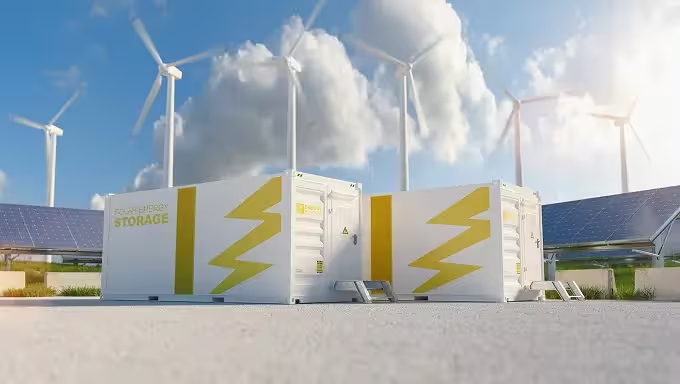How Operators Make Battery Storage a Success
Julian Gerstner from BayWa r.e. shares his learnings for a successful battery storage operation. Julian leads grid scale storage projects and explains why companies need to 'think BESS' to champion the renewable energy transition.

An interview with Julian Gerstner, Head of Storage at BayWa r.e.
Read on to find out:
- Why and how Julian got started in the BESS business
- His main challenges
- Why BayWa r.e. wanted to get started with battery analytics
- What he sees as the key trends for the future
Julian, you have an engineering background. How did you end up working in the battery industry?
I focused on energy storage technologies during my Bachelor's and Master's studies in Renewable Energies. Why? Because, from an engineering perspective, I was convinced that an energy transition would only be possible with functioning and affordable storage technologies.
Nine years ago, when I started my professional career, I wanted to make a name for myself in the utility BESS sector. I wanted to contribute to the global energy transition not from the “production” but rather from the “flexibility” side of the game. There were a lot of PV and wind developers back then. With a focus on energy storage, I could create my own professional unique selling point.
However, most importantly, I did not want to stop with engineering. I built up knowledge in project development & management, energy markets & economics and battery trading.
As the Head of Storage at BayWa r.e., you are responsible for grid scale storage projects. What are the most important responsibilities of your role?
I oversee the complete BESS business in Europe and APAC. I’m responsible for strategy and market entry and I lead a team of BESS experts from development to operation.
Alongside local entities, I work out the business plans, the development targets and timelines as well as the team set up and growth plans.
Batteries play a crucial role in your business and BayWa r.e. started its first BESS projects a couple of years ago. Can you share a few learnings you have gained over the years?
Battery Storage is a crucial pillar of our business along with wind and PV.
The biggest learning for a company with roots in renewable energy is to accept that BESS is a completely different business case. It has different risk profiles and different offtake structures. Many renewable developers are still hesitant to ‘think BESS’ because they are afraid of the business case. Even worse, some still believe that energy storage – especially BESS – is not a sound economic business case. This is often because they lack in-house experts who can take over the capacity building in the company.
The challenge such companies face is to accept that the golden times of feed-in-tariff (FiT), feed-in-premium (FiP) or interesting contract-for-difference schemes will phase out a certain point in time. Then, serious market competition will kick in. Renewable energy developers must accept that they need to deal with the new reality, and they must expand their knowledge into energy markets, day-ahead-market, intraday, and continuous intraday trading and additional revenue streams such as ancillary services. These are terms that a traditional renewable energy developer may not have dealt with in the last15-20 years. This is the biggest challenge. It means a major change in company philosophy and organization. Finding the right people to support the change is still challenging. People with experience in energy markets, trading, storage and the like are rare. A decade ago, only very few people decided to move in that direction.
Working with batteries can be complex. What are the challenges you are struggling with most?
The trend to lithium iron phosphate (LFP) batteries in stationary systems is clear. However, from an operational perspective, State of Charge (SoC) estimation for LFP systems is a big challenge because of the flat voltage curve of LFP batteries. Sudden SoC drops are the reality, making proper trading, aka monetizing, of BESS challenging.
Additionally, nearly all BESS projects I have worked on or know about have had problems due to faulty software updates on the battery management system and / or due to software failures at energy management system level. Outages in data transfer or faulty interfaces also cause troubles during operation.
I have not yet experienced serious failures or quality issues with batteries themselves in my projects.
On the non-BESS side, the biggest challenge is to find experienced E&C (Engineering & Construction) providers. They need to execute the BESS project according to high-quality standards. There are more and more providers in the market, but still not enough. Many projects are reaching a “ready-to-build” stage.
Finally, project financing is often challenging because banks are not very experienced with the merchant risk of BESS and are used to having long term contracts such as FiT for PV or wind plants. Banks also need to go through a paradigm shift.
What are the primary economic factors that influence the viability of your long-term BESS projects?
There are four main things:
- Low capital expenditures and operating expenses,
- A well-designed Battery Offtake Agreement (aka optimization agreement),
- High technical availability: Proper planning of scheduled downtimes means that you avoid downtime during periods of high market prices on DA (day ahead), ID (intraday) and frequency ancillary service market,
- High quality BESS product with low unexpected downtimes and, in case of business interruption, fast supply chain.
Why did you decide to implement battery analytics?
Battery analytics helps us to easily supervise our system during operation, to track whether the BESS is performing well and to avoid potential risk situations. It helps us to increase the lifetime of the BESS and to take preventive measures. By doing predictive maintenance, we can avoid unplanned downtimes.
With battery analytics, we improve our understanding of our BESS in operation even without having an armada of BESS operational & data analytics experts on board (yet). We can easily understand if everything in the BESS is working as it should be. Ultimately, using TWAICE analytics means that our team is able to become better BESS operational experts.
Battery analytics also helps us in case of a claim due to underperformance. We can use the data and have more leverage against the suppliers / OEMs to assert our claims for damages.
Finally, we hope to get improved insurance conditions in the future as we can prove that we take significant care regarding the operational safety of our BESS.
What role does predictive battery analytics play in prolonging the life of your BESS systems and de-risking your operations?
With the 24/7 automatic (predictive) supervision of our assets, we make sure that we are not running into serious issues with the BESS (e.g. thermal runaway, cell failure). We can act early to prevent issues instead of being forced to react. All of this helps to improve BESS lifetime and ensures that the business case remains positive.
How specifically does TWAICE help you?
TWAICE convinced us because of their track record of assets under supervision. The usability of the product was another plus. TWAICE also supported our O&M team in defining the necessary interfaces, infrastructure and protocols so that we could use the software properly. Furthermore, our key account manager at TWAICE is excellent, and very responsive!
During a long assessment process, we compared different analytics providers and felt that TWAICE was very well suited for the operation of our BESS assets.
Furthermore, TWAICE offers a range of products. For example, the digital commissioning support already adds value during project executing and way before operation.
The TWAICE software and dashboards also enable our colleagues from IPP, who are dealing with the asset ownership and operation, to properly oversee our storage fleet with minimal effort.
Looking at the energy storage business, what would you like to see change?
I would like to see more European battery manufacturers becoming successful. It would offer more regional diversification in the supply chain.
On the market side, I hope that more countries create favorable market conditions for BESS to become economically sound. Energy storage – especially BESS – is indispensable for the energy transition.
How do you see the energy storage business develop in the future? What trends are you excited about?
I´m excited about technologies other than lithium-ion becoming more prominent. First and foremost, I hope to develop and build my first sodium-ion BESS soon. I´m also excited to enter the long duration energy storage (>10 h) game. First countries started looking for LDES (long duration energy storage), which is another piece of the puzzle for the energy transition. I´m convinced LDES will play a big role in the future, however I´m still curious to see which technology will dominate this market.
Curious to learn more? Join our live demo!
Sign up for the next live group demo and learn how TWAICE can transform your BESS operations. In just 30 minutes, you’ll get a demo of key features and use cases, and engage with our product experts for a live Q&A.
%201%20(5).avif)
%20(1).avif)
.avif)



